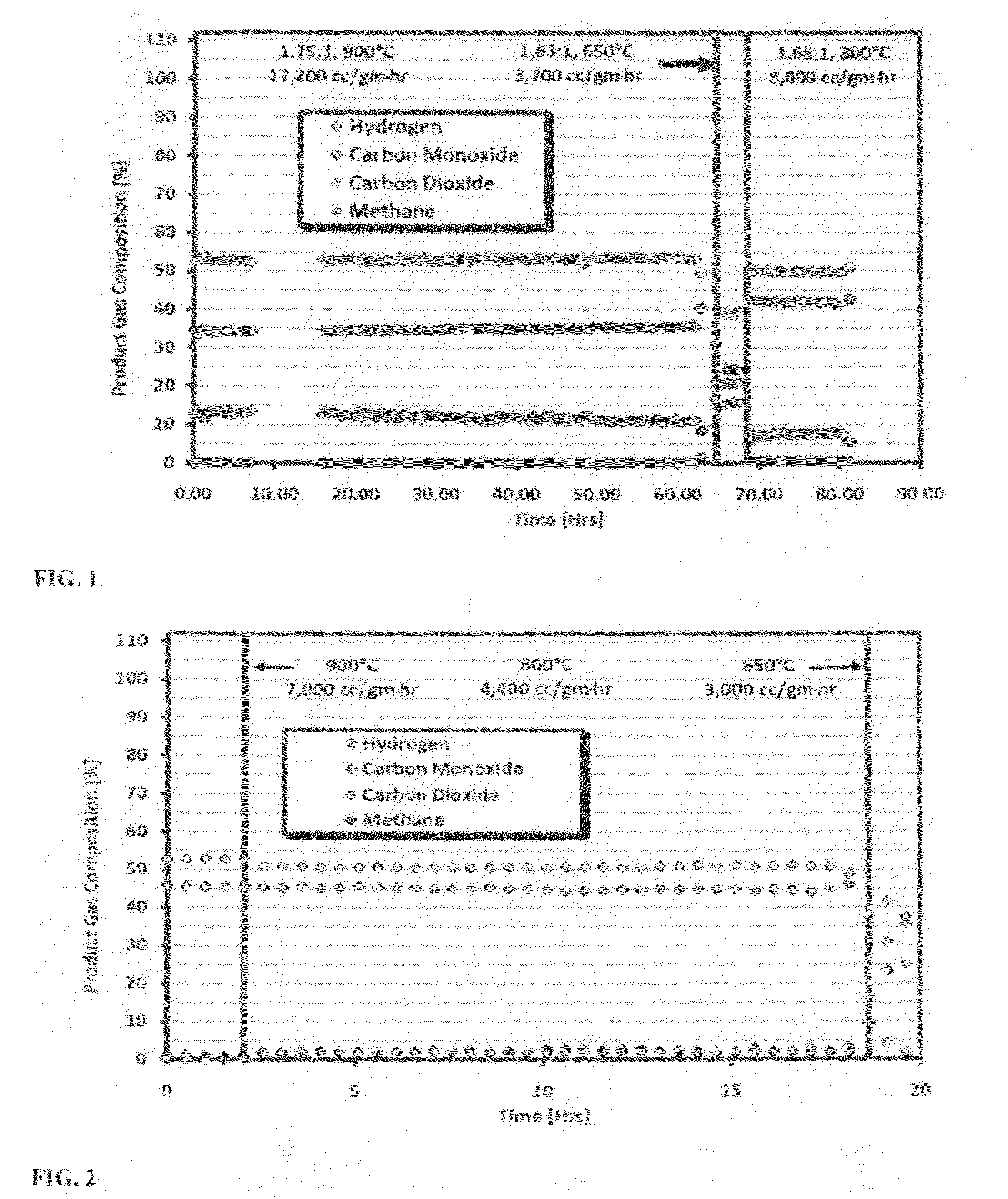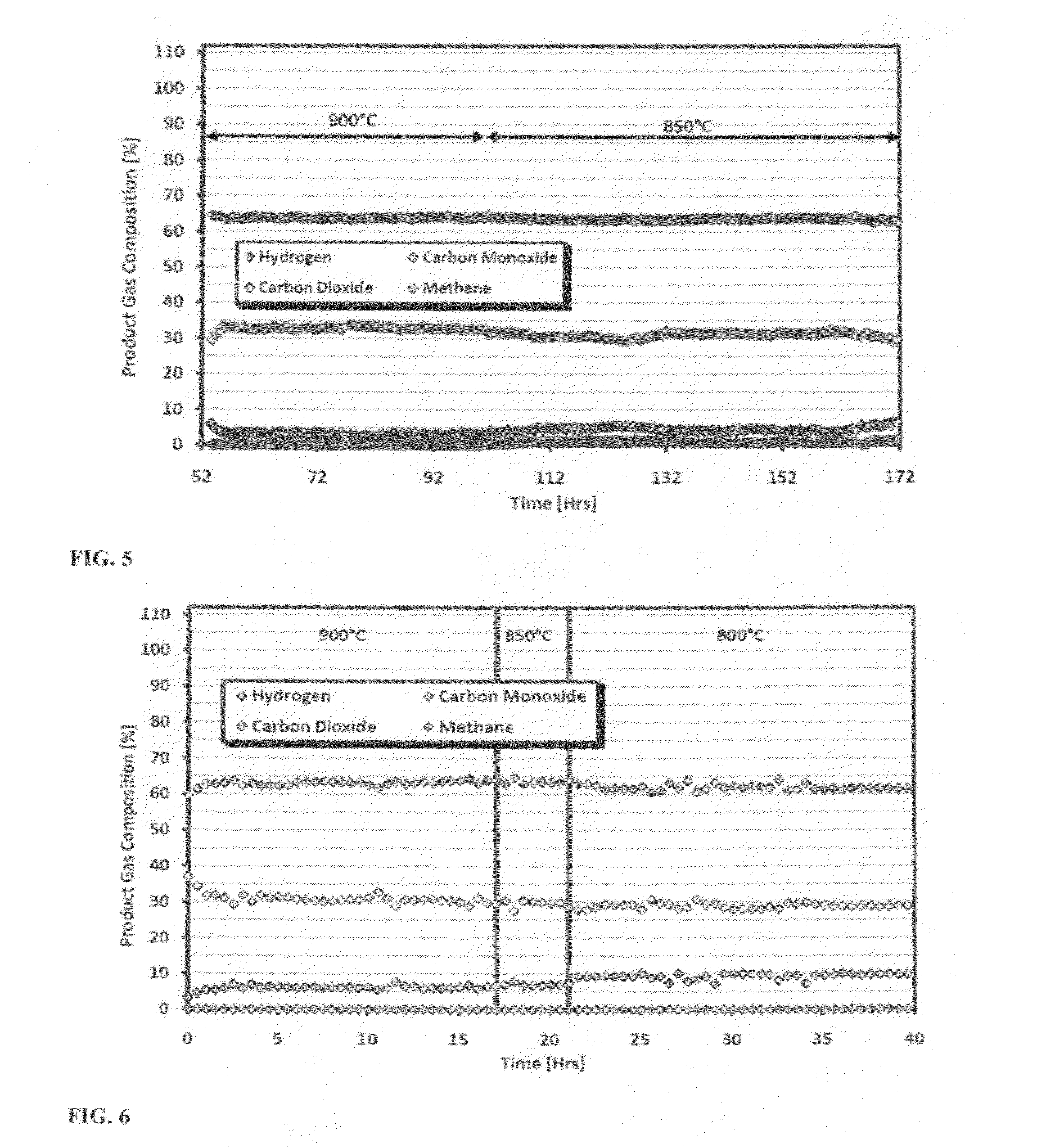Process and catalyst system for the production of high quality syngas from light hydrocarbons and carbon dioxide
a catalyst system and light hydrocarbon technology, applied in metal/metal-oxide/metal-hydroxide catalysts, carburetor gases, chemical production, etc., can solve the problems of rapid carbon deposition, inability to economically recover natural gas or light hydrocarbon resources, coke formation, etc., to achieve high thermal stability, high versatility, and high quality of syngas production
- Summary
- Abstract
- Description
- Claims
- Application Information
AI Technical Summary
Benefits of technology
Problems solved by technology
Method used
Image
Examples
examples
[0050]A variety of tests were conducted on the first catalyst including dry reforming (CO2 and CH4), combination dry / steam reforming (CO2, CH4 & H2O), and tri-reforming (CO2, CH4, H2O & O2). CH4 and CO2 conversions averaged up to 95-100% at the optimum temperatures and gas space velocities. No formation of carbon deposits (coking) on the catalyst was observed in any of these tests. The following sections provide examples that support the superior performance of these catalysts over currently available technologies.
[0051]Dry Reforming—In Dry (or CO2) Reforming, methane and carbon dioxide are reacted and produce a syngas with low H2 / CO ratio of 0.7-1.0:
[0052]Steam Reforming—Steam Methane Reforming (SMR) is an endothermic process where methane is reacted with steam at high temperatures to produce a syngas with a high H2 / CO ratio:
[0053]Partial Oxidation—Reactions for the exothermic oxidation of methane are shown below:
CH4+2O2→CO2+2H2O ΔH1173K=−802.5 kJ mol−1 3
CH4+1.5O2→CO+2H2O ΔH1173K...
example # 1
Example #1
[0057]In this example, the ability of the catalyst to dry reform mixtures of CO2 and CH4 are described. Dry reforming tests were initiated at 1.75 / 1.0CO2 / CH4 and 900° C. (Run A). The results are shown in FIG. 1. The ratio of CO2 / CH4 changed slightly as the space velocity was altered due to insufficient calibration of the flow meters. This problem was discovered during data analysis and was corrected in later runs. At 900° C., full methane conversion was achieved, and the sample operated without loss of activity or pressure increase. At 650° C., the methane conversion was low. The catalyst achieved 95% methane conversion at 800° C. and demonstrated stable performance without pressure increase.
[0058]In the next set of tests, the performance of the catalyst under more challenging conditions was examined (see FIG. 2). The performance of the catalyst with a CO2 / CH4 (1.1 / 1.0) feed was carried out. At 900° C., the complete conversion of methane and carbon dioxide was observed ove...
example # 2
Example #2
[0062]The ability of the catalyst to carry out a combination of dry and steam reforming of CO2, CH4 & H2O is summarized in this example. Combination dry reforming / steam methane reforming tests includes CO2, CH4 and H2O reactants in various molar ratios. In addition to the dry reforming reactions, Steam Methane Reforming (SMR) also occurs and is an endothermic process where methane reacts with steam at high temperatures to produce syngas.
[0063]By combining dry and steam reforming, a syngas with an ideal H2 / CO can be produced. Mixed steam and dry methane reforming tests were conducted to demonstrate activity and determine product composition with methane, CO2, and steam in the feed. In the first test, the reforming mixture was run with the following gas composition: CO2 / CH4 / H2O (0.9 / 1.0 / 2.2) at 900° C.
[0064]The catalyst was found to be stable with lower water content in the feed (at 2O / CH4) as demonstrated in a test with CO2 / CH4 / H2O (0.6 / 1.0 / 1.4) at 900° C. (Test D). Stable ...
PUM
| Property | Measurement | Unit |
|---|---|---|
| temperature | aaaaa | aaaaa |
| size | aaaaa | aaaaa |
| temperatures | aaaaa | aaaaa |
Abstract
Description
Claims
Application Information
 Login to View More
Login to View More - R&D
- Intellectual Property
- Life Sciences
- Materials
- Tech Scout
- Unparalleled Data Quality
- Higher Quality Content
- 60% Fewer Hallucinations
Browse by: Latest US Patents, China's latest patents, Technical Efficacy Thesaurus, Application Domain, Technology Topic, Popular Technical Reports.
© 2025 PatSnap. All rights reserved.Legal|Privacy policy|Modern Slavery Act Transparency Statement|Sitemap|About US| Contact US: help@patsnap.com



